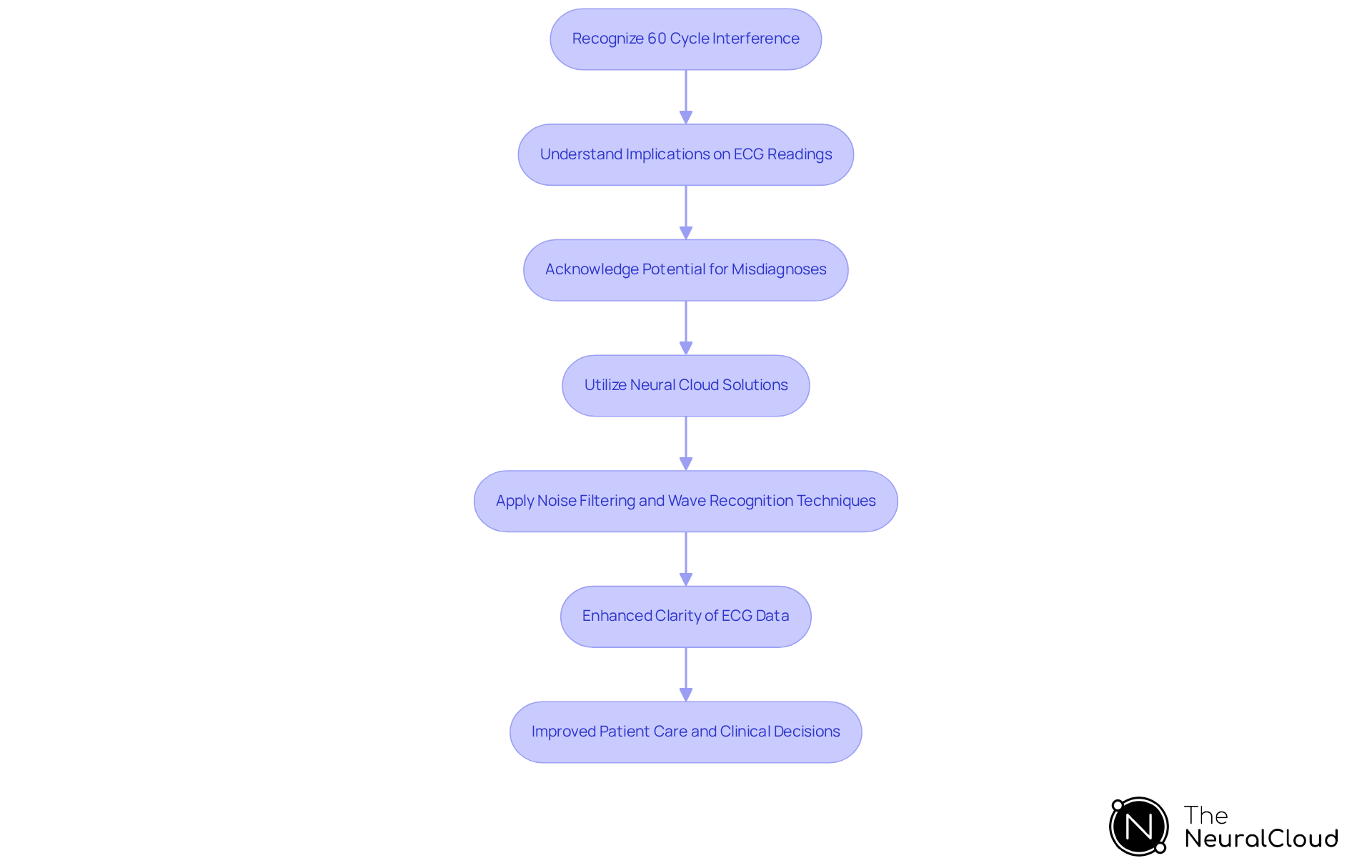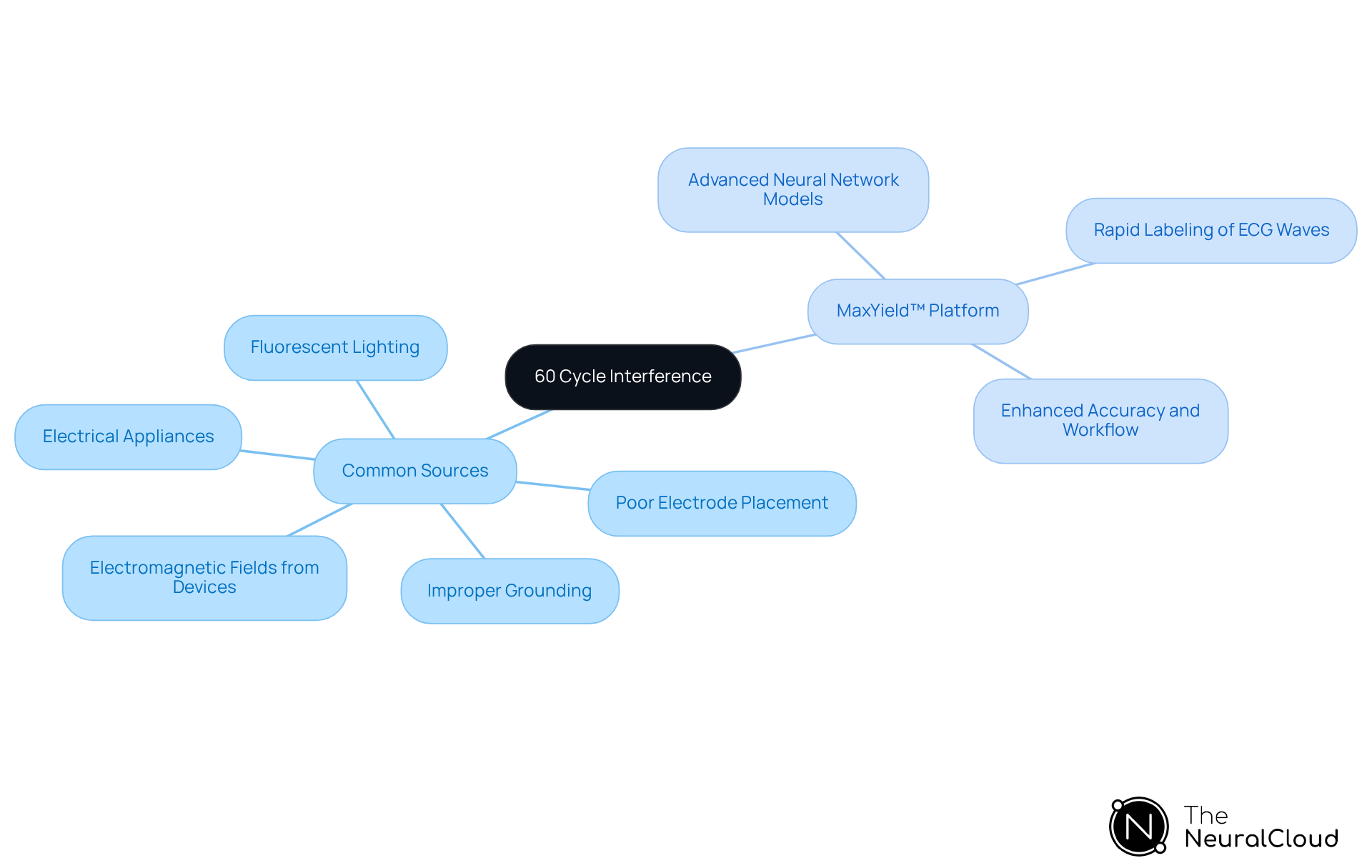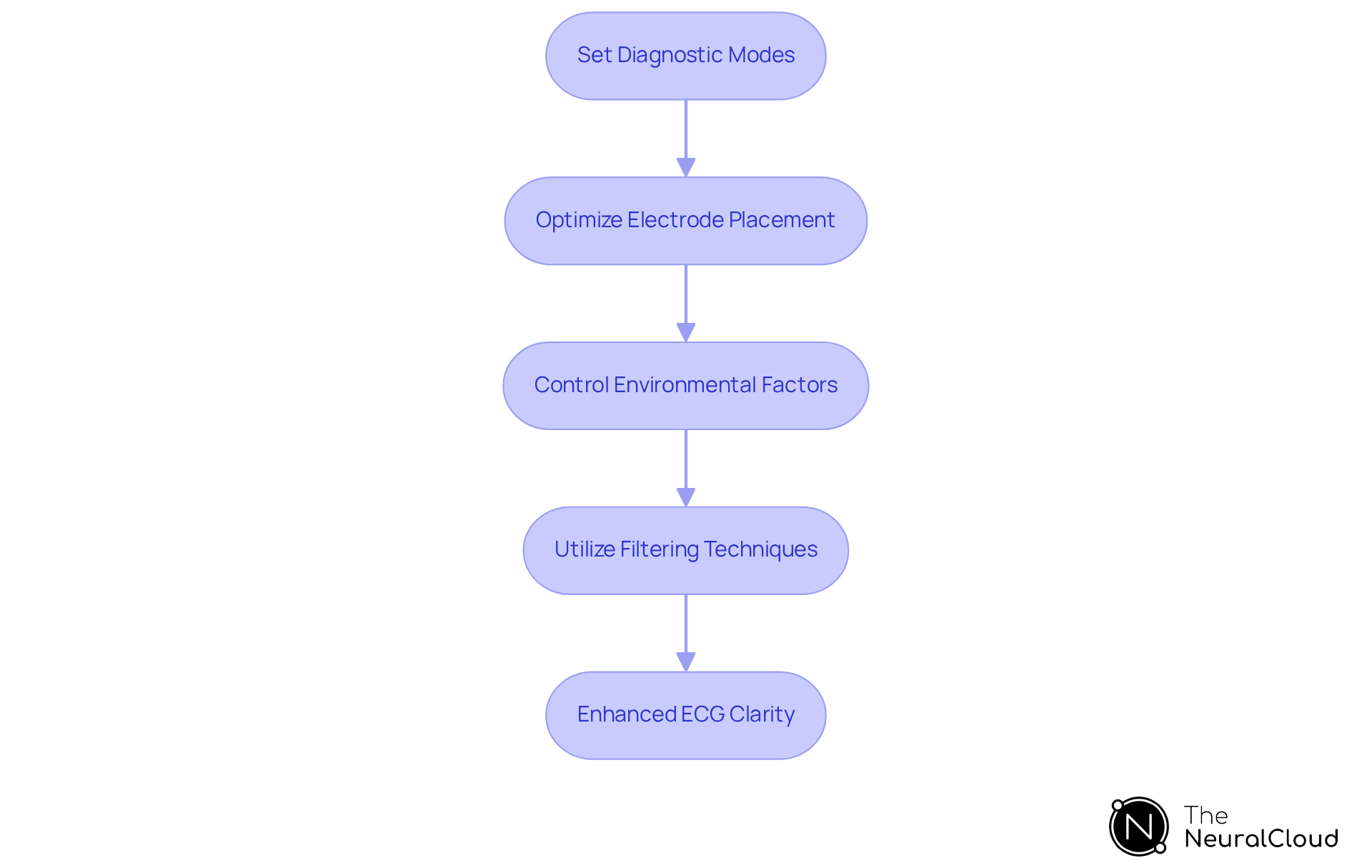Overview
60 cycle interference, commonly referred to as AC disturbance, poses significant challenges in ECG analysis. This interference introduces electrical noise that can obscure authentic cardiac signals, which may lead to misdiagnoses. Recognizing this issue is crucial for healthcare professionals.
The MaxYield™ platform addresses these challenges by employing advanced filtering and wave recognition techniques. These features enhance the clarity and accuracy of ECG readings. As a result, healthcare providers can make more informed decisions, ultimately improving patient care.
Introduction
Understanding the nuances of 60 cycle interference is essential for anyone involved in ECG analysis. This electrical noise can obscure critical cardiac signals, leading to misdiagnoses. The challenge of mitigating this interference persists, prompting the need for advanced solutions. By exploring innovative platforms like MaxYield™, practitioners can significantly enhance the clarity of ECG readings and improve diagnostic accuracy.
The MaxYield™ platform offers a range of features designed to tackle the issues presented by electrical noise. It employs sophisticated filtering techniques that effectively reduce interference, allowing for clearer signal interpretation. Additionally, the platform integrates seamlessly with existing ECG systems, providing a user-friendly interface that enhances workflow efficiency. These advancements not only improve the quality of ECG data but also empower healthcare professionals to make more informed decisions.
The advantages of utilizing MaxYield™ extend beyond just improved readings. By ensuring clearer data, healthcare providers can enhance patient care and reduce the likelihood of misdiagnoses. This ultimately leads to better patient outcomes and increased confidence in ECG analysis. As healthcare professionals navigate the complexities of cardiac diagnostics, the MaxYield™ platform stands out as a vital tool in their efforts to provide reliable patient care.
Define 60 Cycle Interference in ECG Analysis
60 cycle interference, also known as AC disturbance, refers to the electrical noise that impacts ECG readings, primarily caused by alternating current (AC) sources operating at 60 Hz. This disruption appears as a repetitive pattern in the ECG waveform, often manifesting as a thick, fuzzy baseline or oscillations that can obscure genuine cardiac signals. Clinicians must recognize this artifact, as it can mimic arrhythmias or distort the interpretation of cardiac events, potentially leading to misdiagnoses. Understanding 60 cycle interference is crucial for mitigating its effects during .
The 'Neural Cloud Solutions' platform addresses these challenges by utilizing advanced noise filtering and distinct wave recognition techniques. It effectively isolates ECG waves from recordings affected by baseline wander, movement, and muscle artifacts. This capability enhances the clarity of ECG data, allowing healthcare professionals to make more accurate interpretations. Moreover, MaxYield™ recovers previously obscured sections of lengthy Holter, 1-Lead, and patch monitor recordings, thereby improving diagnostic outcomes.
The platform's algorithm evolves with each use, continuously enhancing its accuracy and efficiency over time. By streamlining the ECG analysis process, MaxYield™ not only saves time for healthcare providers but also increases the reliability of cardiac assessments. This advancement in technology ultimately leads to better patient care and more informed clinical decisions.

Identify Sources and Causes of 60 Cycle Interference
Common sources of 60 cycle interference include electrical appliances, fluorescent lighting, and equipment that is improperly grounded. Electrical devices such as computers, monitors, and even mobile phones can emit electromagnetic fields that interfere with ECG signals. Additionally, poor electrode placement or insufficient skin preparation can exacerbate the effects of this disruption. Understanding these sources enables healthcare practitioners to create a controlled environment for ECG monitoring, thereby reducing the likelihood of disruption and ensuring more accurate readings.
The MaxYield™ platform addresses these challenges effectively. It utilizes advanced neural network models for complex data processing, allowing for rapid labeling of P, QRS, and T Wave onsets and offsets. This feature aids in identifying and mitigating the effects of interference, enhancing the overall quality of ECG analysis. By extracting key features from ECG readings, MaxYield™ empowers health tech developers to analyze more information in less time, leading to clearer data sets and reliable indicators.
The benefits of using MaxYield™ are significant for healthcare professionals. With , practitioners can identify new digital biomarkers more efficiently. The platform not only enhances the accuracy of readings but also streamlines the workflow, allowing for better patient care. By leveraging this technology, healthcare providers can ensure they are equipped with the tools necessary to navigate the complexities of ECG monitoring.

Analyze Effects of 60 Cycle Interference on ECG Signals
The presence of 60 cycle interference can significantly distort ECG signals, resulting in the misinterpretation of critical cardiac events. This disruption obscures P-waves, QRS complexes, and T-waves, making it challenging to accurately evaluate heart rhythm and rate. In some instances, the interference caused by 60 cycle interference may mimic arrhythmias, resulting in unnecessary alarms or misdiagnoses. Clinicians must be vigilant about these effects, including 60 cycle interference, to avoid drawing incorrect conclusions from ECG data that could adversely affect patient care and treatment decisions.
Neural Cloud Solutions' MaxYield™ platform addresses these challenges by employing Gold Standard Methodologies. It features advanced noise filtering and wave recognition capabilities that streamline workflow, automate repetitive tasks, and process more data in less time. The platform's data wall effectively tackles the challenges of physiological variability and signal artifacts, enhancing the overall efficiency of ECG analysis.
By utilizing the MaxYield™ platform, healthcare professionals can improve their diagnostic accuracy and response times. The integration of these advanced features not only mitigates the impact of signal disruption but also empowers clinicians to focus on patient care. This results in better-informed and ultimately improves patient outcomes.

Implement Strategies to Mitigate 60 Cycle Interference
To mitigate 60 cycle interference, healthcare professionals can utilize several strategies outlined in user manuals, which can be further enhanced by MaxYield™ technology.
- Set Diagnostic Modes: Adjust the diagnostic mode of the ECG monitor to filter out frequencies below 0.05 Hz and above 40 Hz, minimizing interference. The system enhances these configurations automatically for superior clarity.
- Optimize Electrode Placement: Ensure proper electrode placement and skin preparation to reduce noise from muscle contractions and movement. MaxYield™'s X-Factor Mapping visualizes optimal electrode arrangements for enhanced quality.
- Control Environmental Factors: Minimize the use of electrical devices near the ECG monitoring area and use shielded cables to reduce electromagnetic interference. This system offers immediate insights on environmental factors influencing transmission quality.
- Utilize filtering techniques by implementing , such as notch filters, to specifically target and eliminate 60 cycle interference from the ECG data. The system employs advanced AI-driven filtering methods that adaptively enhance the ECG signal for clearer readings.
By applying these strategies, particularly with the integration of MaxYield™, clinicians can significantly enhance the clarity of ECG readings, leading to more accurate diagnoses and improved patient outcomes.

Conclusion
Understanding 60 cycle interference is essential for healthcare professionals involved in ECG analysis, as it greatly impacts the accuracy of cardiac assessments. This electrical noise, primarily stemming from alternating current sources, can obscure critical cardiac signals, resulting in misinterpretations and potential misdiagnoses. By recognizing and addressing this interference, clinicians can enhance their diagnostic capabilities and ensure improved patient outcomes.
This article highlights several key strategies and technological advancements that can alleviate the effects of 60 cycle interference. By optimizing electrode placement, controlling environmental factors, and employing advanced filtering techniques with platforms like MaxYield™, healthcare providers can significantly enhance the clarity of ECG readings. The integration of such technologies not only streamlines the analysis process but also empowers clinicians to concentrate on delivering high-quality patient care.
Ultimately, the importance of mastering 60 cycle interference is paramount. As the field of electrocardiography continues to advance, embracing these innovative techniques and tools will be crucial for healthcare professionals. By prioritizing the reduction of interference in ECG analysis, practitioners can improve diagnostic accuracy, leading to more informed treatment decisions and better patient outcomes. Taking proactive steps in this direction is vital for navigating the complexities of cardiac monitoring and ensuring the highest standard of care.
Frequently Asked Questions
What is 60 cycle interference in ECG analysis?
60 cycle interference, also known as AC disturbance, refers to electrical noise that affects ECG readings, primarily caused by alternating current (AC) sources operating at 60 Hz. It appears as a repetitive pattern in the ECG waveform, often as a thick, fuzzy baseline or oscillations that can obscure genuine cardiac signals.
How does 60 cycle interference affect ECG readings?
This interference can mimic arrhythmias or distort the interpretation of cardiac events, potentially leading to misdiagnoses. Clinicians must recognize this artifact to mitigate its effects during ECG analysis.
What solutions are available to address 60 cycle interference?
The 'Neural Cloud Solutions' platform offers advanced noise filtering and distinct wave recognition techniques to isolate ECG waves from recordings affected by baseline wander, movement, and muscle artifacts, enhancing the clarity of ECG data.
How does the MaxYield™ feature improve ECG analysis?
MaxYield™ recovers previously obscured sections of lengthy Holter, 1-Lead, and patch monitor recordings, thereby improving diagnostic outcomes and allowing healthcare professionals to make more accurate interpretations.
Does the algorithm used in the Neural Cloud Solutions platform improve over time?
Yes, the platform's algorithm evolves with each use, continuously enhancing its accuracy and efficiency, which streamlines the ECG analysis process.
What are the benefits of using advanced ECG analysis technology like MaxYield™?
This technology saves time for healthcare providers, increases the reliability of cardiac assessments, and ultimately leads to better patient care and more informed clinical decisions.






